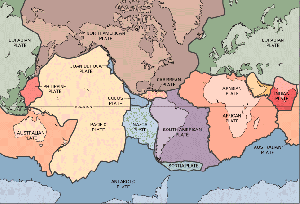(Redirected from
Indian Plate)

The Indian plate is shown in red on this map
The India or Indian Plate is a minor tectonic plate. Part of the major Indo-Australian Plate, it contains the subcontinent of India and a portion of the basin under the Indian Ocean.
About 90 million years ago, in the late Cretaceous Period, the India Plate split from Madagascar off the east coast of Africa. It began moving north, at about 15 cm/yr (6 in/yr), and began colliding with Asia between 50 and 55 million years ago, in the Cenozoic Era. During this time, the India Plate covered a distance of 2,000 to 3,000 km (1,200 to 1,900 mi), and moved faster than any other known plate.
The collision with the Eurasian Plate along the boundary between India and Nepal formed the orogenic belt that created the Tibetan Plateau and the Himalaya Mountains, as sediment bunched up like earth before a plow.
The India Plate is currently moving northeast at 5 cm/yr (2 in/yr), while the Eurasian Plate is moving north at only 2 cm/yr (0.8 in/yr). This is causing the Eurasian Plate to deform, and the India Plate to compress at a rate of 4 mm/yr (0.15 in/yr).
2004 Indian Ocean earthquake
The 9.0 magnitude 2004 Indian Ocean earthquake was caused by stress in the subduction zone where the India Plate is sliding under the Burma Plate in the eastern Indian Ocean, at a rate of 6 cm/yr (2.5 in/yr). The Sundra Trench is formed along this boundary where the Indo-Australian and Eurasian Plates meet. Earthquakes in the region are either caused by thrust-faulting, where the faultline slips at right angles to the trench; or strike-slip faulting, where material to the east of the faultline slips along the direction of the trench.
Like all similarly large earthquakes, the December 26, 2004 event was caused by thrust-faulting. A 100 km (60 mi) rupture caused about 1,200 km (750 mi) of the interface to slip, which moved the fault 15 m (50 ft) and lifted the sea floor several meters (yards).
See also
External links
Last updated: 05-07-2005 09:30:04
Last updated: 05-13-2005 07:56:04